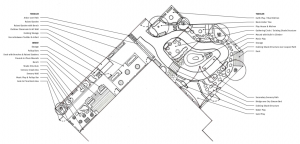I recently attended a design workshop facilitated by Early Childhood Health Outdoors (ECHO) and the Natural Wildlife Federation in preparation for the redevelopment of the infant and toddler playground at one of the early childhood centers I work closely with. The existing playground faces challenges often experienced by programs situated in the heart of urban environments. The playground is small, surrounded by concrete (buildings, sidewalks, and parking lots), with essentially no greenery in site. Needless to say, we have our work cut out for us in transforming this space into an infant/toddler oasis in the middle of the city.
Because outdoor space is at a premium, it has given us a great excuse to nix the playground equipment (the usefulness of which is often debated anyway) in exchange for a natural playscape. There is a plethora of research on the positive impact of natural outdoor play environments for young children; the benefits of which are particularly applicable in an urban setting including increased physical activity, improved social relations, and a reduction in stress. As our design team mapped out our space, established priorities, and penciled out our new space, there were a few key elements that rose to the top of our “must have” list.
Primary pathway – One of the biggest benefits of having outdoor space and incorporating its use into the curriculum is to give children the opportunity to move (something we appreciate tremendously, as not all urban programs have the gift of outdoor space)! With that, we thought it was important for a primary pathway (one where the children can walk, run, and ride) to be the heart of the playscape. Not only will it allow for activities that promote gross motor development, it will create flow, and allow for the organization of all of the other outdoor elements that will surround it.
Moderate visibility – In urban environments we cannot always control the view beyond our program’s fence. That notion sparked some initial discussion about the installation of a privacy fence around the playground. Not being able to see out of the space however, can be a safety concern, and minimizes the ability to use the surrounding community as a learning environment. Instead, the existing fence will remain, and some strategic privacy elements will be added. For example, the use of climbing vines, trees, and other greenery will create some visual barriers in key places along the playground’s perimeter. We will also use structural elements, including a playhouse and a music wall to create added privacy.
Raised garden beds – With a desire to bring the indoors out (think traditional learning concepts like language development, math, and science) and very limited greenery, container gardens and raised beds were the perfect solution for this playscape! Growing fruits and vegetables in raised beds, situated at levels that are easily accessible to the children will allow for active participation in the gardening process. Children will engage in learning that enhances all aspects of development, and yields products that can then be used to further enhance the curriculum. Best of all, this element can be placed virtually anywhere (given there is sunlight and water, of course)!
There are many other elements that will be included in the new space (which will be completed in stages), but ultimately, this natural playscape will provide infant and toddler teachers with the opportunity to bring the indoors outdoors. In order to maximize its use and the learning that will occur as a result, it was not enough to simply design a new space. Creating “buy-in” by incorporating teaching staff into the design process was critical. In addition, providing professional development to teaching staff on the benefits of a natural playscape and how to engage children in each of its elements is key. Lastly, educating families (who may be used to seeing climbers, slides, and swings) on what children learn through nature-based play will ensure that everyone will welcome and enjoy the new landscape of the early childhood center.

